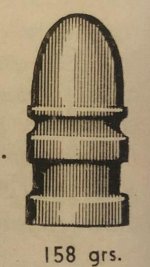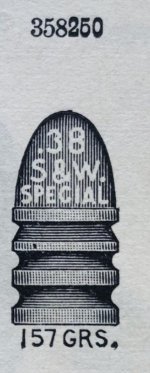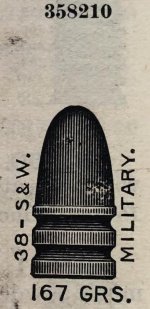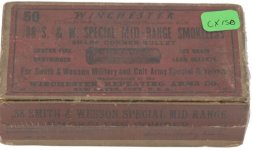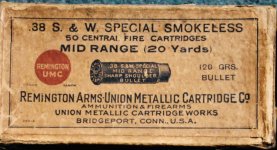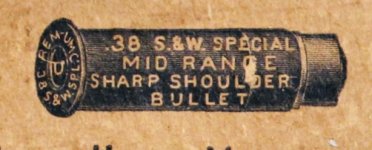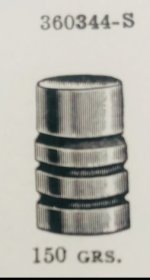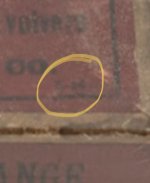Actually,
I’ve done some in depth research on the Semi-Wadd and Wadcutter subject.
In the Himmelwright book circa 1904 all the early target load listings are Round nose bullets.
It wasn’t until 1905 that these “SHARP SHOULDER” or “SQUARE SHOULDER” bullets showed up. That’s what they called them. See photo with S’ designator.
I’ve read that the design goes back to 1903 but I’ve found nothing to support any listings.
What’s really interesting about this subject is what they actually were introduced as? What their initial purpose was?
I have a very early box of Smokeless Police 38 Special rounds and they are Wadcutters that are listed on the box as Sharp Shoulder MAN STOPPERS!
So it is also possible that the early WC & SWC design was for police work that just happened to work well at the range for target shooters.
Elmer Kieth also used SWC 44 Mags for big game hunting. In his book he swore by them so there is some history to the stopping power of the original SHARP SHOULDER bullet design that just happens to cut a perfect hole in paper.
Murph
Ideal No.429220 (Himmelwright's original "wad cutter", for the .44 Russian) was introduced in Ideal Handbook No.13 (1900). The same design, adapted for the .38 S&W Military (aka .38 Special), was No.360302 and showed up in Ideal Handbook No.18 (1907). No.360270, the "Man Stopper", debuted in Ideal Handbook No.17 (1906), but disappeared from the Handbooks until No.28 (1927) only to disappear again after No.31 (1934 & 1935).
According to the Ideal Handbook descriptions, the Himmelwright "wad cutter" bullets were "
designed especially to cut a clean full-sized hole in the target. This it does to perfection." This description was equally applied to No.360271, a "semi-wadcutter" (and the first to be so designated) designed by B. F. Wilder and first appearing in Handbook No.18 (1907).
Ideal Handbook No.17 (1906) has this to say about the No.360270 "Man-Killer":
360270. For .38 Colt's New Army, New Navy, Marine Corps and Officers' Model, also S. & W. Military Revolvers. Much has been said about the .38 caliber revolver not having sufficient killing power for military use. Our new "Man-Stopper" bullet in the above revolvers with a charge of 2-1/2 to 3 grains' weight of Laflin & Rand "Bulls-Eye" powder will be found accurate and a killer.
1911 seems to have been the "bumper crop" year for the wadcutter and semi-wadcutter, with the following making their initial appearance in Ideal Handbook No.22:
C. E. Heath's No.429336 250gr. SWC;
C. C. Crossman's No.360344 150gr. SWC;
J. B. Crabtree's No.360345 115gr. SWC;
Sidney E. Sears' No.429348 173gr. WC; and
M. L. Homan's No.429352 245gr. WC
A 20-year gap ensues, during which there are only a very few new WC or SWC designs introduced to the shooting public until Elmer Keith's No.429421, No.429422, No.454423, No.454424, and No.358429, all of which were initially shown in Ideal Handbook No.30 (1931).
Jim

